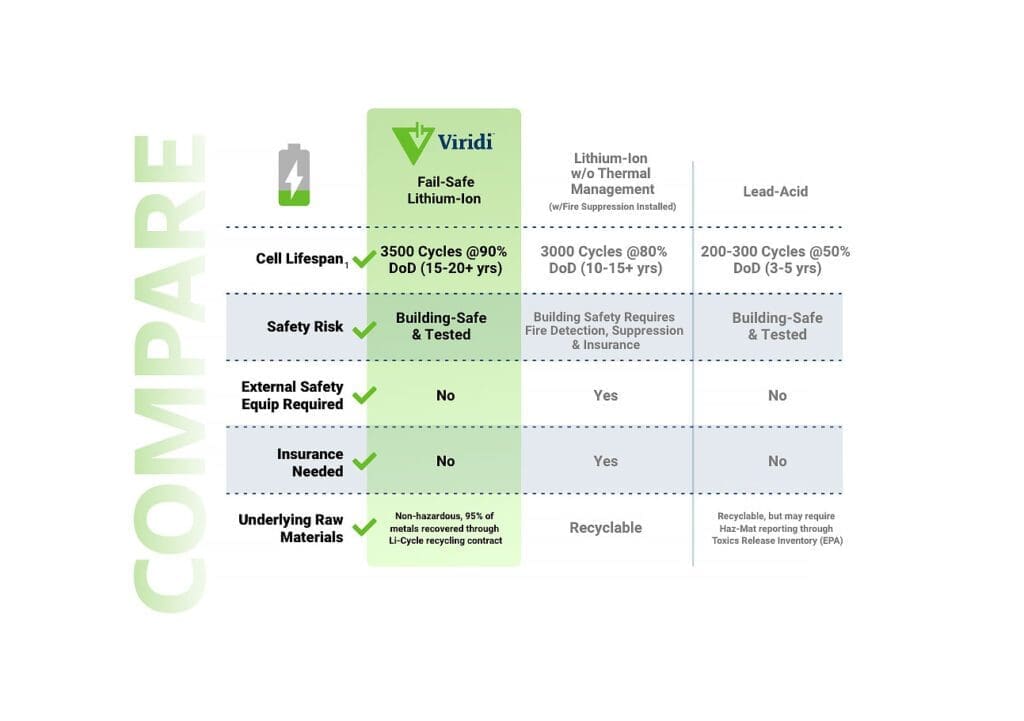Fail-Safe Battery Energy Storage Behind the Meter
Solutions for Unprecedented Sustainable Energy, Resilience and Revenue Generation.
Connect with our Energy Storage Team at RE+ 2023 Sept 11-14
To understand what a VPP, or Virtual Power Plant, is, first you should understand what a Distributed Energy Resource, or DER is. A DER is a device capable of interacting with the electric grid–either by producing energy (like the solar panels on your neighbor’s garage or a wind turbine at a family farm) or providing capacity (like a smart thermostat or electric vehicle charger able to turn on and off at certain times based grid conditions).
Firms are focused more than ever on understanding and controlling their energy usage, and are installing DERs of all sorts, in buildings one at a time, or across worldwide campuses. Their goals are numerous: to gather data, produce more local energy, save on energy bills, generate revenue through VPP or Demand Response services, and measure and control the shift away from carbon intense generation, among others. However, on an individual basis DERs tend to be too small to influence the available energy on the large, sprawling electric grid.
A Virtual Power Plant is a collection of DERs that can be remotely aggregated together and coordinated with grid operations. If enough DERs can be controlled simultaneously, their ability to deliver controlled energy can rival traditional brick and mortar power plants.
Any firm looking to enroll its DER assets in VPP services to generate revenue should be focused on dispatchability. As the grid adds new loads like EV charging and electrified heating, and new intermittent renewable generators like solar and wind, the swings in supply and demand will intensify throughout the day, week, and season. This will create major opportunities for DERs to respond to this volatility, and supply grid firming services at a local level–as long as they can be called upon to do so quickly. As great as DERs like rooftop solar and wind turbines are, they are not dispatchable. At least, not without energy storage.
Energy storage is the holy grail of DER technology, offering the ability to store excess energy when it isn’t needed and deliver it later during times of peak demand. And at a distributed scale, no technology matches the capabilities of Lithium-Ion Battery Energy Storage Systems. Aggregating large numbers of distributed, remote-controllable batteries into VPP portfolios is big business. But how do we create a world with sufficient, dispatchable battery storage, and what are the barriers that Lithium-Ion faces today?
Viridi’s fail-safe lithium-ion technology provides the ideal solution for behind-the-meter energy storage, allowing for safe deployment in and around occupied spaces. With high power (w/kg) and energy (wh/kg) densities, this technology enables any BTM application, including resiliency, peak shaving, and rate arbitrage. The fail-safe design of Viridi’s batteries passively stops thermal runaway at the cell level, eliminating the need for fire suppression equipment.
Lead acid batteries, despite being widely used, have limitations when it comes to resiliency and energy density. With poor energy density (wh/kg), lead acid arrays only provide short bursts of resiliency, limiting practical discharge durations to 20-60 minutes. This makes them unsuitable for use cases like peak shaving and rate arbitrage. Additionally, lead acid batteries have a relatively short lifespan, requiring cell replacements every 3-5 years. While they offer low fire risk and allow for indoor installations, their heavy arrays require a significant amount of dedicated floor space.
Lithium-ion batteries, on the other hand, offer improved energy density, allowing for a greater range of applications, including resiliency, peak shaving, and rate arbitrage. With good lifespan (3,000 cycles @ 80% DOD), lithium-ion cells can be used regularly for approximately 10-15 years before replacement. However, their high fire risk limits deployments to dedicated outbuildings and requires extensive fire detection and suppression systems. The need for thermal/offgas alarms and liquid/foam sprinklers can significantly increase costs and insurance premiums.

Lithium-ion cells can undergo a powerful chemical reaction called thermal runaway when they experience a fault. This reaction causes the cell to release all its remaining energy at once, resulting in hazardous smoke, sparks, flames, and even explosions. Moreover, under thermal runaway, neighboring cells can be triggered, leading to thermal propagation and igniting the entire battery pack. Viridi’s fail-safe design effectively prevents thermal runaway and propagation, ensuring a safe and reliable energy storage solution.
Viridi’s RPS50 includes patented Pack Level Anti-Propagation Technology, eliminating fire risk and ensuring safe deployment in and around occupied spaces. It is the only battery pack designed and tested to UL residential safety standards, providing peace of mind to users. Safety is the most uncompromising design principle for Viridi, and their patented technology meets the highest safety standards.

Deploy a Mobile Energy Storage System to the remediation site to provide reliable power and safeguard the community during the long cleanup process.
A Medical Research lab recently purchased a set of high-powered electron microscopes. Though only used for brief periods, their draw exceeded the capacity of their building’s electric infrastructure. So, instead of a long and costly utility upgrade, they call on Viridi’s RPS50 stationary batteries to provide fail-safe, peak power at its point of use–inside their facility.
When a world-famous art festival needed remote power for their annual party in the desert, they turned to mobile energy storage. They set up a temporary city on the sand for seventy thousand people, which they clean up after a week of festivities. Instead of using portable diesel generators, they chose mobile energy storage to avoid the high cost of fuel, logistical challenges of transporting fuel tanks, and the noise and fumes of diesel engines.
Logistics hubs, facing high fuel and maintenance costs, are exploring a shift to electric vehicles (EVs) for lower operating expenses. EV owners prioritize fast charging, favoring Level 3 DC fast chargers that can rapidly charge vehicles. However, the significant power spikes from these chargers may strain the electric grid, necessitating costly upgrades to the facility’s electrical infrastructure. One cost-effective solution is deploying battery storage to mitigate power peaks.
Viridi’s fail-safe lithium-ion technology addresses the critical safety concerns associated with energy storage deployment in or around occupied spaces, providing unmatched control, security, and convenience. With its high power and energy density, long lifespan, and superior safety features, Viridi’s solution is a reliable and efficient choice for various BTM applications. DOWNLOAD INFOGRAPHIC
Ready to embrace the future of energy storage? Contact us today to learn more about Viridi’s fail-safe lithium-ion technology and how it can transform your energy resilience strategy.

Experience unwavering support with 24/7 technical assistance, because we stand firmly behind our products.
Contact Our Energy Experts: 1-716-968-8658
QUICK LINKS
COMPANY